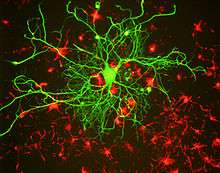EnCor Biotechnology
EnCor Biotechnology is a United States company that manufactures antibodies to neural and yeast proteins. Founded in 1999 as a spin-off from the University of Florida by Gerry Shaw, a British scientist and professor at the University of Florida, the company is based in Gainesville, Florida and markets antibody reagents originally made for research purposes, but which also have commercial value.
 | |
| Private | |
| Industry | Biotechnology |
| Founder | Gerry Shaw |
| Headquarters | , United States |
Area served | Worldwide |
Key people | Gerry Shaw |
| Products | Antibodies to neural and yeast proteins |
| Website | Homepage of EnCor |
History
EnCor Biotechnology was formed in at the end of 1999 to market antibody reagents originally made for research purposes, but which also had some commercial potential.[1] Three years later EnCor moved into rented lab space at the Sid Martin Biotechnology Incubator, a facility dedicated to commercialization of intellectual property generated in the University of Florida. The company quickly become profitable and, in 2006, relocated to new premises in Gainesville.[2]

In 2005, EnCor began collaborating with basic scientists and clinicians to produce articles in peer reviewed scientific publications focused on the examination of various plasma, serum and CSF biomarkers of nervous system damage and degeneration. One of these is the phosphorylated, axonal form of the major neurofilament protein heavy chain protein which has the HGNC name NEFH,[3][4][5][6] though is usually referred to as pNF-H in the scientific literature. Two further studies describe novel EnCor assays for UCHL1[7] and alpha-synuclein,[8] two major brain proteins implicated in the development of Parkinson's and other neurological diseases.
By 2020, EnCor product line had increased to almost 250 products, the antibodies mostly being used for research purposes, with a particular focus on immunocytochemistry and western blotting, though many are also utilized for immunoprecipitation and ELISA. Some have become useful for diagnostic histopathology and for monitoring the levels of protein biomarkers, of research and potential clinical utility. EnCor supplies reagents to research labs and other reagent companies such as Abcam, BioLegend, Thermo Fisher Scientific, EMD Millipore, Bio-Techne and many others. EnCor is well known for the quality of its cell, tissue and western blotting images, many of which have been made available on Wikipedia Commons and widely used in books, articles, posters and many other venues, see [].
Publications
- Shaw G, Yang C, Ellis R, Anderson K, Parker Mickle J, Scheff S, Pike B, Anderson DK, Howland DR (Nov 2005). "Hyperphosphorylated neurofilament NF-H is a serum biomarker of axonal injury". Biochem. Biophys. Res. Commun. 336 (4): 1268–1277. doi:10.1016/j.bbrc.2005.08.252. PMID 16176808.
References
- "Biotech venture | Gainesville.com". gainesville.com. 2012. Retrieved 2 May 2012.
- "UF professor's biotech firm graduates | Gainesville.com". gainesville.com. 2012. Retrieved 2 May 2012.
- Shaw G, Yang C, Ellis R, Anderson K, Parker Mickle J, Scheff S, Pike B, Anderson DK, Howland DR (Nov 2005). "Hyperphosphorylated neurofilament NF-H is a serum biomarker of axonal injury". Biochem. Biophys. Res. Commun. 336 (4): 1268–1277. doi:10.1016/j.bbrc.2005.08.252. PMID 16176808.
- Anderson KJ, Scheff SW, Miller KM, Roberts KN, Gilmer LK, Yang C, Shaw G (Sep 2008). "The phosphorylated axonal form of the neurofilament subunit NF-H (pNF-H) as a blood biomarker of traumatic brain injury". J. Neurotrauma. 25 (9): 1079–1085. doi:10.1089/neu.2007.0488. PMC 2820728. PMID 18729720.
- Gresle MM, Shaw G, Jarrott B, Alexandrou EN, Friedhuber A, Kilpatrick TJ, Butzkueven H (Dec 2008). "Validation of a novel biomarker for acute axonal injury in experimental autoimmune encephalomyelitis". J. Neurosci. Res. 86 (16): 3548–3555. doi:10.1002/jnr.21803. PMID 18709652.
- Boylan K, Yang C, Crook J, Overstreet K, Heckman M, Wang Y, Borchelt D, Shaw G (Dec 2009). "Immunoreactivity of the phosphorylated axonal neurofilament H subunit (pNF-H) in blood of ALS model rodents and ALS patients: evaluation of blood pNF-H as a potential ALS biomarker". J. Neurochem. 111 (5): 1182–1191. doi:10.1111/j.1471-4159.2009.06386.x. PMID 19765193.
- Lewis SB, Wolper R, Chi YY, Miralia L, Wang Y, Yang C, Shaw G (May 2010). "Identification and preliminary characterization of ubiquitin C terminal hydrolase 1 (UCHL1) as a biomarker of neuronal loss in aneurysmal subarachnoid hemorrhage". J. Neurosci. Res. 88 (7): 1475–1484. doi:10.1002/jnr.22323. PMID 20077430.
- Tinsley RB, Kotschet K, Modesto D, Ng H, Wang Y, Nagley P, Shaw G, Horne MK (Sep 2010). "Sensitive and specific detection of α-synuclein in human plasma". J. Neurosci. Res. 88 (12): 2693–2700. doi:10.1002/jnr.22417. PMID 20648655.